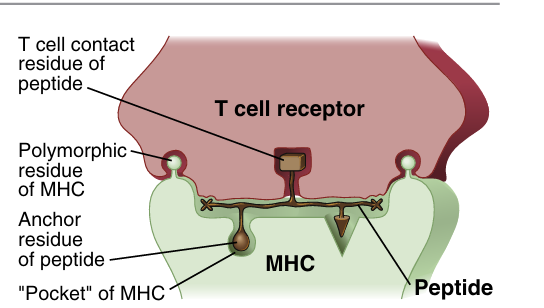
Antigens Recognized by T Lymphocytes
 المؤلف:
Abbas, A. K., Lichtman, A. H., & Pillai, S
المؤلف:
Abbas, A. K., Lichtman, A. H., & Pillai, S
 المصدر:
Basic Immunology : Function and disorders of immune system
المصدر:
Basic Immunology : Function and disorders of immune system
 الجزء والصفحة:
6th ed , page 52
الجزء والصفحة:
6th ed , page 52
 2025-02-12
2025-02-12
 955
955
The majority of T lymphocytes recognize peptide anti gens that are bound to and displayed by the MHC molecules of antigen-presenting cells (APCs). The MHC is a genetic locus whose principal protein products function as the peptide display molecules of the immune system. CD4+ and CD8+ T cells can see peptides only when these peptides are displayed by that individual’s MHC molecules. This property of T cells is called MHC restriction. The T cell receptor (TCR) recognizes some amino acid residues of the peptide antigen and simultaneously also recognizes residues of the MHC molecule that is displaying that peptide (Fig. 1). Each TCR, and hence each clone of CD4+ or CD8+ T cells, recognizes one peptide displayed by one of the many MHC molecules in every individual. Also, some small populations of T cells recognize lipid and other nonpeptide antigens either presented by nonpolymorphic class I MHC–like molecules or without a requirement for a specialized antigen display system.

fig1. Model showing how a T cell receptor recognizes a complex of peptide antigen displayed by an MHC molecule. Major histocompatibility complex (MHC) molecules are expressed on antigen-presenting cells and function to display peptides derived from protein antigens. Peptides bind to the MHC molecules by anchor residues, which attach the peptides to pockets in the MHC molecules. The antigen receptor of every T cell recognizes some amino acid residues of the pep tide and some (polymorphic) residues of the MHC molecule.
The cells that capture microbial antigens and dis play them for recognition by T lymphocytes are called antigen-presenting cells (APCs). Naive T lymphocytes must see protein antigens presented by dendritic cells to initiate clonal expansion and differentiation of the T cells into effector and memory cells. Differentiated effector T cells again need to see antigens, which may be presented by various kinds of APCs besides dendritic cells, to activate the effector functions of the T cells in both humoral and cell-mediated immune responses. We first describe how APCs capture and present antigens to trigger immune responses and then examine the role of MHC molecules in antigen presentation to T cells.
 الاكثر قراءة في المناعة
الاكثر قراءة في المناعة
 اخر الاخبار
اخر الاخبار
اخبار العتبة العباسية المقدسة


